In this guide, we’ve shared the most common and effective types of well water filters you’re likely to come across today. We’ve also offered a simple formula for choosing the most suitable well water filtration system for you.
📌 Key Takeaways
- The most common types of well water filter systems are whole-home filters, sediment filters, and UV purifiers.
- Media types used in well water filtration systems include KDF, carbon, activated alumina, ion exchange, and reverse osmosis membranes (with pre-treatment).
- To choose the best well water filtration system for you, consider your water quality, your household size, your budget, and your maintenance preferences.
Table of Contents
🚿 Different Kinds of Well Water Filtration Systems Explained
Read on to learn which types of water filters you’re likely to come across for well water filtration.
Sediment Filters
For most well owners, sediment filters are the best place to start.
A sediment water filter removes physical particles of sediment, sand, dirt, and other debris from your drinking water. It uses a filter media, typically made of fiberglass, pleated paper, or polypropylene, to block contaminants from passing through the filter.
Different sediment filters have different micron ratings. Typically, the micron size in a sediment water filter ranges from 5 to 50.
📌 The smaller the micron rating, the more sediment a filter can remove (i.e. a 5-micron filter can reduce particles as small as 5 microns, while a 10-micron filter can only reduce particles down to 10 microns), but sediment filters with small micron ratings become clogged at a faster rate due to their more thorough contaminant removal.
You can buy different sediment filters for different locations, such as pre-filtration to a large filtration system for whole-home or under-sink use, or a standalone point of entry filter.
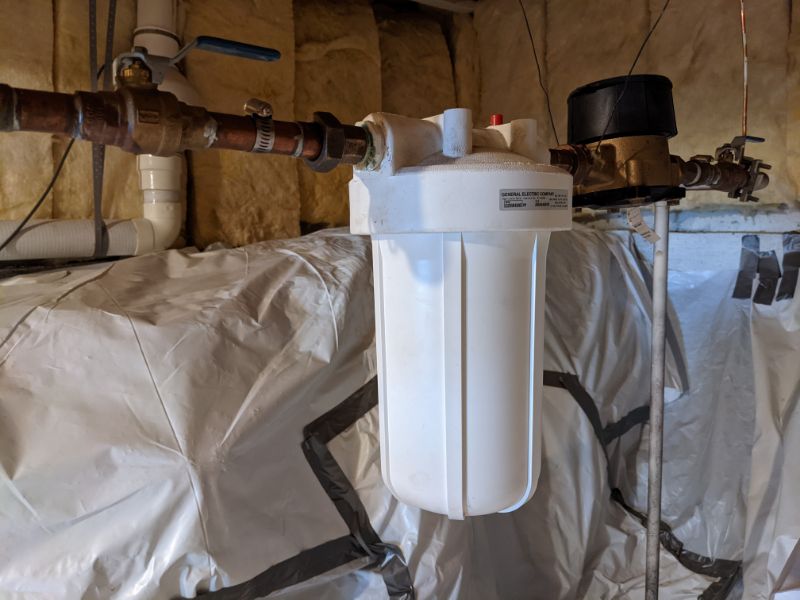
Air or Chemical Injection Filters
Another popular filtration system for treating well water is the air or chemical injection/ oxidation system.
This type of system oxidizes dissolved iron, manganese, and sulfur – three common well water contaminants – and filters them out of water, typically with birm or manganese greensand media.
📌 We recommend air injection systems over chemical injection systems because they’re lower-maintenance and don’t require adding dangerous chemicals to your water.
Air injection systems are exclusively designed for whole-home use. They’re installed at your main water line, upstream of your hot water heater. The best systems remove up to 10-20 PPM of iron, as well as up to 5 PPM of manganese and sulfur.
UV Water Purifiers
If you want to ensure your well water is consistently microbiologically safe, the best well water filter for you is a UV water purifier.
UV purifiers emit ultraviolet light, which penetrates the DNA of microorganisms, deactivating them and preventing them from replicating.
Most UV lamps are designed to be installed at your point of entry, downstream of a multi-stage water treatment system. It’s wise to install a pre-filter before a UV purifier because UV light can’t penetrate turbid or TDS-heavy water.
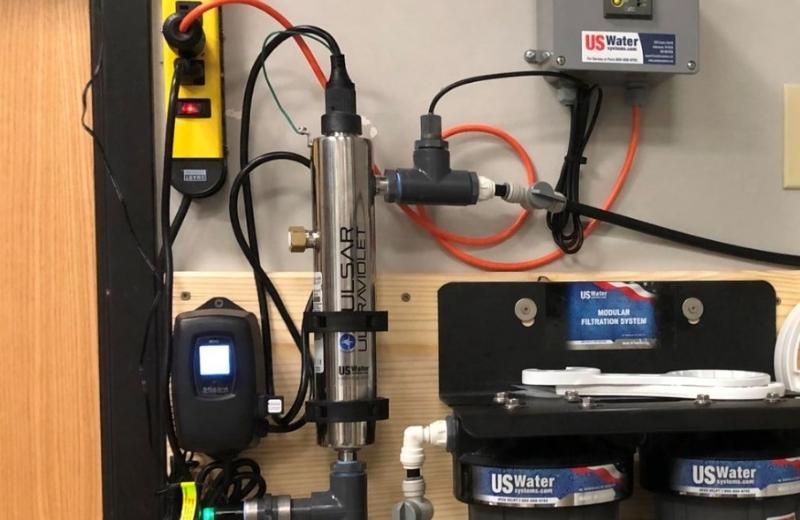
Water Softeners
A water softener isn’t actually classed as a drinking water filter, but we wanted to include it on this list since it’s such a popular form of treatment for well water.
Water softeners use the ion exchange process to remove scale-causing minerals (such as calcium and magnesium) from drinking water. To balance out the water’s charge, these minerals are replaced with another ion: sodium.
A water softener can only be installed as a whole-home system, providing treatment before water enters your appliances and water heaters.
There are salt-free softeners for people who prefer not to add salt to their tap water.
Reverse Osmosis Systems
A reverse osmosis system provides the most effective filtration of all – but you’ll need to take precautions if you plan to use this kind of system for well water.
Reverse osmosis filters send water through numerous filtration stages, including a sediment and carbon filter, and a semi-permeable membrane. The semi-permeable membrane is capable of reducing more than 99.9% of total dissolved solids, including volatile organic compounds, chemicals, heavy metals, and microorganisms.
The most common types of RO drinking water filters are under-sink systems and countertop systems. Whole-home reverse osmosis systems are slowly increasing in popularity, but these systems are extremely expensive, so they’re not an appealing option for everyone.
📌 Keep in mind that you’ll probably need to install a pre-filter before a reverse osmosis system to remove sediment and hardness minerals, which may damage the RO membrane.
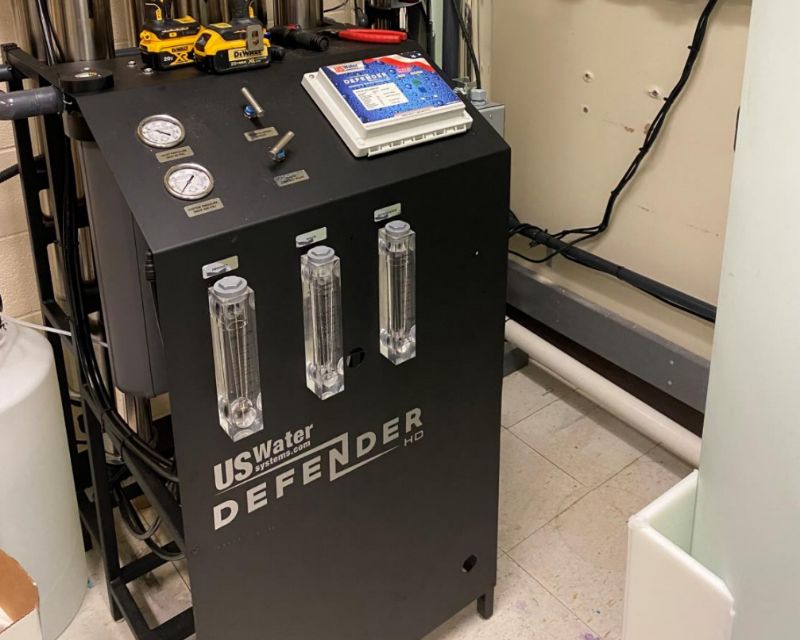
Activated Alumina
Multi-stage well water filters sometimes use a filtration media known as activated alumina.
Activated alumina is made from a naturally occurring compound called aluminum oxide, which is treated to become porous and highly adsorptive. This type of filter can remove two specific contaminants from well water: arsenic and fluoride.
Activated alumina filters may be combined with other filter media or used in standalone filter cartridges in whole-home systems.
KDF Filters
KDF stands for Kinetic Degradation Fluxion, and a KDF filter uses the oxidation-reduction process (redox) to reduce several common types of contaminants in water.
The metals in a KDF media produce an electric charge that effectively reduces contaminants as water passes through the media.
There are several different types of KDF media, including KDF-55 (which reduces chlorine and heavy metals), KDF-85 (which filters out iron and hydrogen sulfide), and KDF-C coarse mesh (which reduces water-soluble heavy metals and chlorine).
KDF filter media is often combined with other filter media, like carbon filters, to increase their effectiveness.
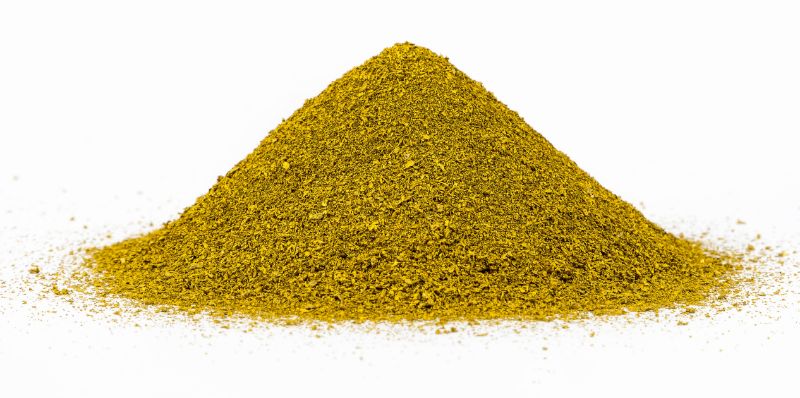
Ion Exchange Filters
The most common use of ion exchange is in a water softener (which we’ve discussed above). But ion exchange filters may also be used to remove radium and heavy metals, like lead and copper, from water.
Cation exchange is the most common form of ion exchange. A cation exchange resin exchanges positively charged ions on a negatively charged resin.
Ion exchange filters are usually installed alongside other filter media, like carbon filters, in a multi-stage filtration system.
Learn more about the differences between cation exchange vs anion exchange.
Ultrafiltration
Ultrafiltration uses membrane separation technology, like reverse osmosis membranes. These filters have fine pores that block even bacteria and viruses (which are very small) from passing through.
It’s common for ultrafiltration membranes to be combined with other forms of well water filtration, like sediment filters or carbon filters, in whole-house or point-of-use applications.
Again, ultrafiltration requires a suitable form of pre-treatment when used to filter well water, to prevent damage to the UF membrane.
Carbon Filters
Carbon filters are last on our list because they’re most commonly used to treat chlorinated city water, not well water.
However, some types of carbon filters are still pretty useful as a well water treatment stage, depending on what your water contains.
Activated carbon filters are treated with oxygen, which gives the media a large, adsorptive surface area.
Some of the contaminants removed by a good activated carbon filter are chlorine, herbicides, VOCs, pesticides, and trihalomethanes (a disinfection byproduct).
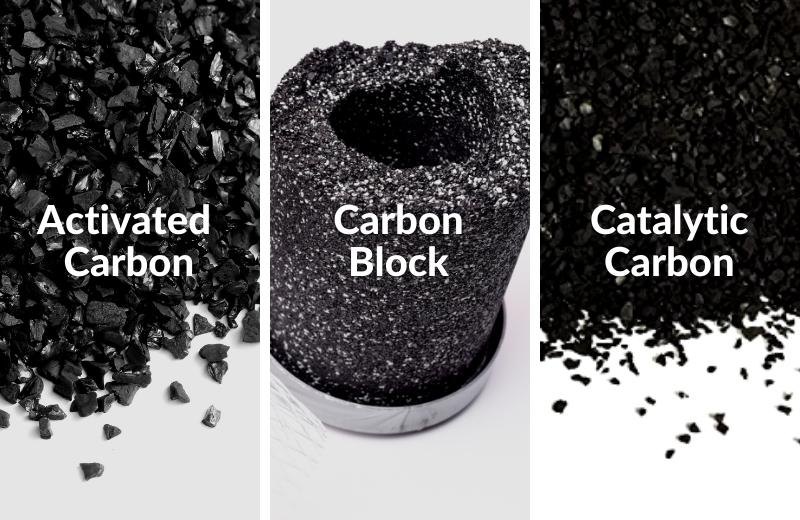
There are several types of activated carbon filter media to be aware of:
Granular Activated Carbon (GAC)
Granular activated carbon is made from loose carbon granules and is often used to filter large volumes of water in a whole-home system.
Catalytic Carbon
Catalytic carbon is an enhanced version of activated carbon that’s more reactive and reduces additional contaminants, including hydrogen sulfide and chloramine.
Carbon Block
Carbon block filters use compressed carbon to reduce contaminants more thoroughly than GAC filters. This type of filter media has a higher density, and works best with slower flow rates.
📤 Well Water Filtration Systems Applications
Different well water filtration systems have different applications. The most common use applications:
- Under-sink
- Countertop
- Gravity filtration
- Faucet attached
- Whole home/ point of entry
- Showerhead
- Refrigerator
Some filters can be installed in several locations, depending on their size and intended use. For instance, a sediment cartridge may be installed as a standalone whole house filter cartridge, or it might be used as a pre-stage to a larger whole home filter system, or an under-sink drinking water unit.
📌 We recommend considering whole house filtration systems if your budget allows. A whole home filter provides filtered water throughout your entire plumbing system, including your water heaters, all your showerheads and drinking water faucets, and all your water-using appliances.
On the other hand, under-sink, countertop, and faucet-attached filters are a cheaper filtration solution, but they’ll only filter the tap water at your kitchen sink.
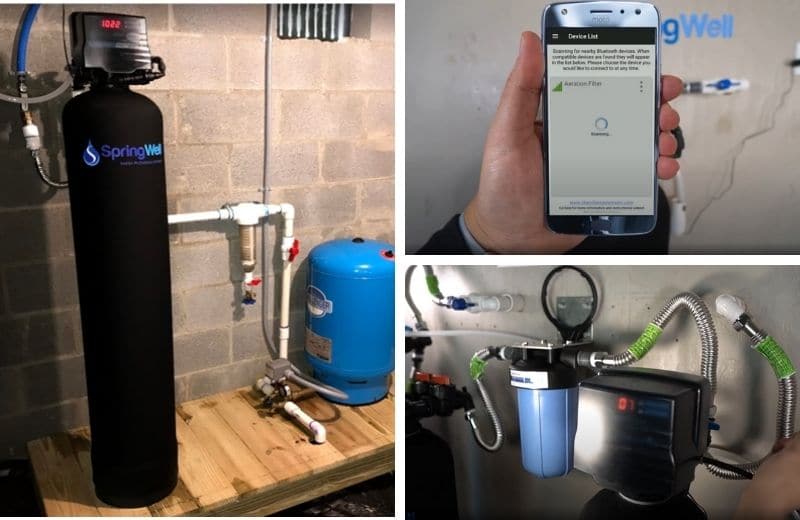
📰 How to Choose the Best Well Water Filtration System For You
To make sure your chosen well water filtration system is ideal for your needs, consider the following factors:
Your Water Quality
You can’t buy a water filter until you know what your water contains – and therefore what you need to remove.
Some of the most common well water contaminants are sediment, iron, manganese, hardness minerals, nitrate, nitrite, and arsenic. Because well water isn’t disinfected like city water, it also poses a risk of microbiological contamination.
We recommend getting your water tested by a certified laboratory, which will tell you exactly what contaminants are in your water, and to what levels. You can use this information to narrow down your choice to specific systems that can remove these contaminants.

Your Household Size
The size of your household determines your water usage and required flow rate – which determines the required size of the water filtration system.
Correctly sizing the system is especially important if you plan to buy a whole house water filter. The system needs to be big enough to handle your water pressure, preventing a significant reduction in the flow of water around your home.
📌 Most small families of 1-2 need a flow rate of 8-10 GPM for a whole house water filter, while families of 4 need a 12-15 GPM system, and families of 5 or more need a 15 GPM+ system.
The larger the system, the more space it’ll take up. Make sure to measure your available space carefully before buying a system to make sure the unit fits comfortably.
Your Budget
Depending on how flexible you can be, your budget might be one of the most limiting factors when it comes to which types of well water filter systems you can buy.
If your budget is big – say, $2,000+ – you’ll be able to choose between pretty much every filter type out there, including whole house water filter systems, under-sink systems, reverse osmosis systems, and more. You’ll also be able to consider optional add-ons and upgrades, like UV purifiers and remineralization stages for RO systems.
📌 If your budget is smaller, you may need to be more strategic with what you buy. A great way to save money is to install a standalone sediment filter at your home’s point of entry, then use a water filter pitcher to remove the bulk of the contaminants in your water.
Make sure you factor in the cost of maintenance when considering your budget. Most whole-house filter systems cost $50-$200 to maintain per year, while under-sink units cost $25-100. It just depends on the type of maintenance required.

Your Maintenance Preferences
The amount of maintenance you prefer to do will also affect your choices of water filters.
📌 If you prefer a low-maintenance solution, look for tank-based whole-house water filtration systems, which contain a media that typically lasts 5-10 years. These require far less maintenance than cartridge-based systems, which have one or several water filters that require replacing every 6-12 months, on average.
Don’t buy a water filter unless you’re committed to the maintenance involved in owning it. A well water filter system quickly becomes useless when the filters are clogged and dirty.
Related content:
- Learn the Must-Buy Acid Neutralizers for Well Water of 2025
- Want to get rid of iron in well water? Check out the 7 Top Performing Iron Filters for Well Water
- How can you effectively purify well water for drinking?
- Learn about Well Water Filtration System Rental Options
❔ Types of Well Water Filter Systems: FAQ
What water filter is best for well water?
The best water filter for well water depends on your water quality. For example, if your water is high in sediment, but otherwise fine, a sediment filter is best for you. Or, if you have high water hardness, a water softener is your best choice. You could even go all out and install a sediment pre-filter and a water softener upstream of a reverse osmosis water filtration system, which removes more than 99% of all total dissolved solids.
What is the best way to filter well water for drinking?
The best way to filter well water for drinking is to use a multi-stage system or two separate filtration systems. This means you can target multiple groups of contaminants at once. For instance, you could choose to install a sediment filter alongside an air injection system to reduce sediment and iron, manganese, and sulfur in your water.
How much does a well filtration system cost?
The average cost of a whole home well water filtration system is $1,200-$2,500, depending on the system type. An under-sink well water filter costs $200-$400, and a countertop filter costs $100-$300+.
Are point of entry or point of use filters better for well water?
Point of entry systems (or whole home systems) are the best choice if you want to protect your entire home from the contaminants in your water. Meanwhile, point of use filters (such as under-sink, countertop, faucet-mounted, pitcher, shower, refrigerator, and gravity filters) are the best choice if you just want to filter water in a specific location.

